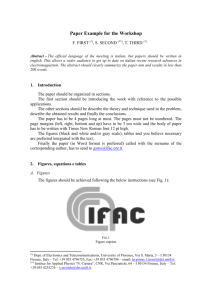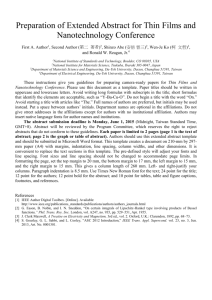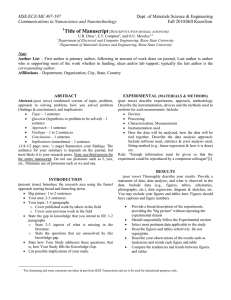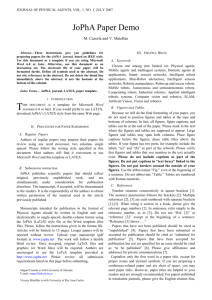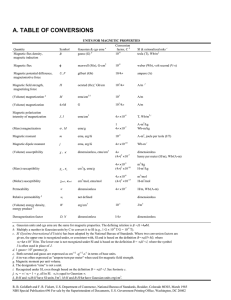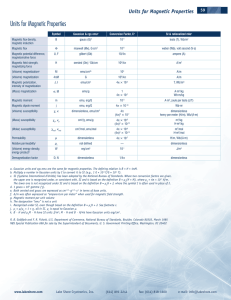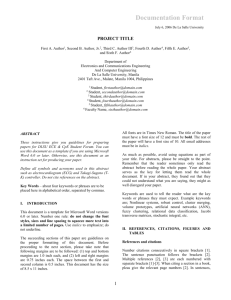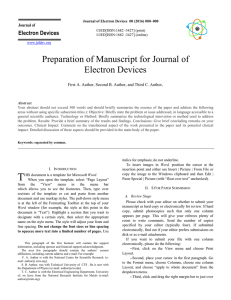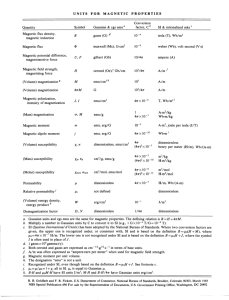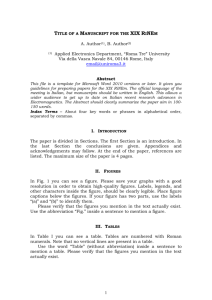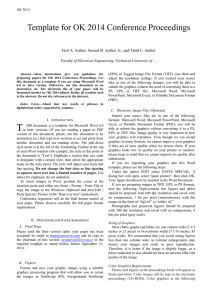Low-Voltage Logic Design: 16-bit Carry Skip Adder
advertisement
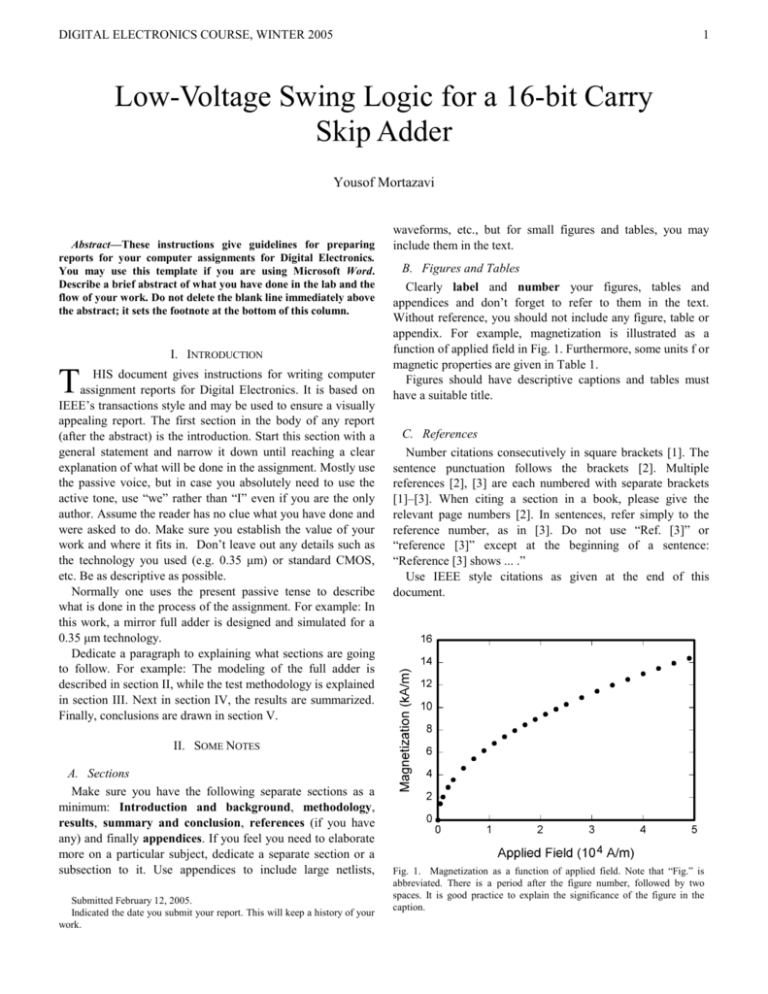
DIGITAL ELECTRONICS COURSE, WINTER 2005 1 Low-Voltage Swing Logic for a 16-bit Carry Skip Adder Yousof Mortazavi Abstract—These instructions give guidelines for preparing reports for your computer assignments for Digital Electronics. You may use this template if you are using Microsoft Word. Describe a brief abstract of what you have done in the lab and the flow of your work. Do not delete the blank line immediately above the abstract; it sets the footnote at the bottom of this column. I. INTRODUCTION T HIS document gives instructions for writing computer assignment reports for Digital Electronics. It is based on IEEE’s transactions style and may be used to ensure a visually appealing report. The first section in the body of any report (after the abstract) is the introduction. Start this section with a general statement and narrow it down until reaching a clear explanation of what will be done in the assignment. Mostly use the passive voice, but in case you absolutely need to use the active tone, use “we” rather than “I” even if you are the only author. Assume the reader has no clue what you have done and were asked to do. Make sure you establish the value of your work and where it fits in. Don’t leave out any details such as the technology you used (e.g. 0.35 μm) or standard CMOS, etc. Be as descriptive as possible. Normally one uses the present passive tense to describe what is done in the process of the assignment. For example: In this work, a mirror full adder is designed and simulated for a 0.35 μm technology. Dedicate a paragraph to explaining what sections are going to follow. For example: The modeling of the full adder is described in section II, while the test methodology is explained in section III. Next in section IV, the results are summarized. Finally, conclusions are drawn in section V. waveforms, etc., but for small figures and tables, you may include them in the text. B. Figures and Tables Clearly label and number your figures, tables and appendices and don’t forget to refer to them in the text. Without reference, you should not include any figure, table or appendix. For example, magnetization is illustrated as a function of applied field in Fig. 1. Furthermore, some units f or magnetic properties are given in Table 1. Figures should have descriptive captions and tables must have a suitable title. C. References Number citations consecutively in square brackets [1]. The sentence punctuation follows the brackets [2]. Multiple references [2], [3] are each numbered with separate brackets [1]–[3]. When citing a section in a book, please give the relevant page numbers [2]. In sentences, refer simply to the reference number, as in [3]. Do not use “Ref. [3]” or “reference [3]” except at the beginning of a sentence: “Reference [3] shows ... .” Use IEEE style citations as given at the end of this document. II. SOME NOTES A. Sections Make sure you have the following separate sections as a minimum: Introduction and background, methodology, results, summary and conclusion, references (if you have any) and finally appendices. If you feel you need to elaborate more on a particular subject, dedicate a separate section or a subsection to it. Use appendices to include large netlists, Submitted February 12, 2005. Indicated the date you submit your report. This will keep a history of your work. Fig. 1. Magnetization as a function of applied field. Note that “Fig.” is abbreviated. There is a period after the figure number, followed by two spaces. It is good practice to explain the significance of the figure in the caption. DIGITAL ELECTRONICS COURSE, WINTER 2005 2 TABLE I UNITS FOR MAGNETIC PROPERTIES Symbol B Conversion from Gaussian and CGS EMU to SI a Quantity H m magnetic flux magnetic flux density, magnetic induction magnetic field strength magnetic moment M magnetization 4M j J magnetization specific magnetization magnetic dipole moment magnetic polarization , susceptibility mass susceptibility permeability r w, W N, D relative permeability energy density demagnetizing factor 1 Mx 108 Wb = 108 V·s 1 G 104 T = 104 Wb/m2 1 Oe 103/(4) A/m 1 erg/G = 1 emu 103 A·m2 = 103 J/T 1 erg/(G·cm3) = 1 emu/cm3 103 A/m 1 G 103/(4) A/m 1 erg/(G·g) = 1 emu/g 1 A·m2/kg 1 erg/G = 1 emu 4 1010 Wb·m 1 erg/(G·cm3) = 1 emu/cm3 4 104 T 1 4 1 cm3/g 4 103 m3/kg 1 4 107 H/m = 4 107 Wb/(A·m) r 1 erg/cm3 101 J/m3 1 1/(4) No vertical lines in table. Statements that serve as captions for the entire table do not need footnote letters. aGaussian units are the same as cgs emu for magnetostatics; Mx = maxwell, G = gauss, Oe = oersted; Wb = weber, V = volt, s = second, T = tesla, m = meter, A = ampere, J = joule, kg = kilogram, H = henry. III. METHODOLOY Explain your methodology and details of your design/implementation. Describe what you did in past tense using a passive voice. Give as much details as you can, and describe the reasoning behind some of the decisions you had to make. IV. RESULTS Results must be summarized in a table in a way that stands out. The reader should be able to get a good idea of what was done and what results were obtained by just looking at the results and the summary and conclusions sections that follows the results. V. SUMMARY AND CONCLUSION Summarize your work and draw conclusions in this section. The most important part of your assignments is this section. Try to point out what you learned from doing this lab. What challenges did you face and how did you solve them. How can you explain your results. If they are different than what you expected, what could be the reasons? Give as much thought to this section as you can, because your conclusions are the main purpose of doing the assignments. REFERENCES G. O. Young, “Synthetic structure of industrial plastics (Book style with paper title and editor),” in Plastics, 2nd ed. vol. 3, J. Peters, Ed. New York: McGraw-Hill, 1964, pp. 15–64. [2] W.-K. Chen, Linear Networks and Systems (Book style). Belmont, CA: Wadsworth, 1993, pp. 123–135. [3] H. Poor, An Introduction to Signal Detection and Estimation. New York: Springer-Verlag, 1985, ch. 4. [4] J. U. Duncombe, “Infrared navigation—Part I: An assessment of feasibility (Periodical style),” IEEE Trans. Electron Devices, vol. ED11, pp. 34–39, Jan. 1959. [5] S. Chen, B. Mulgrew, and P. M. Grant, “A clustering technique for digital communications channel equalization using radial basis function networks,” IEEE Trans. Neural Networks, vol. 4, pp. 570–578, July 1993. [6] R. W. Lucky, “Automatic equalization for digital communication,” Bell Syst. Tech. J., vol. 44, no. 4, pp. 547–588, Apr. 1965. [7] S. P. Bingulac, “On the compatibility of adaptive controllers (Published Conference Proceedings style),” in Proc. 4th Annu. Allerton Conf. Circuits and Systems Theory, New York, 1994, pp. 8–16. [8] Basic Book/Monograph Online Sources) J. K. Author. (year, month, day). Title (edition) [Type of medium]. Volume(issue). Available: http://www.(URL) [9] J. Jones. (1991, May 10). Networks (2nd ed.) [Online]. Available: http://www.atm.com [10] (Journal Online Sources style) K. Author. (year, month). Title. Journal [Type of medium]. Volume(issue), paging if given. Available: http://www.(URL) [11] R. J. Vidmar. (1992, August). On the use of atmospheric plasmas as electromagnetic reflectors. IEEE Trans. Plasma Sci. [Online]. 21(3). pp. 876—880. Available: http://www.halcyon.com/pub/journals/21ps03vidmar [1] APPENDIX 1 Use appendices as needed, after referring to them in the text. The appendices may be single column or double column. Number the pages and give each a proper number and title. Try to make the columns of the last page equal in height.
